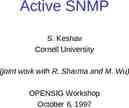Advertising Chapter 19
35 Slides1.35 MB
Advertising Chapter 19
Advertising and It’s Purpose Advertising is nonpersonal promotion which promotes ideas, goods or services by using a variety of media. The average city dweller is exposed to more than 3,000 advertising messages everyday Advertisers control the message, where it will be seen or heard, and how often it will be repeated
Advertising and It’s Purpose Marketers can use advertising to introduce a new business or change a company image Advertising can also promote a new product or an existing one, encourage the use of a particular service, or encourage businessto-business transactions Two main types of advertising: Promotional Advertising Institutional Advertising
Promotional Advertising Definition Advertising designed is to increase sales Targets are consumers or B2B customers Encourages potential customers to ask for info, call for appointment, participate on the internet, or enter a retail store. Leads / Prospecting
Institutional Advertising Definition Designed to create a favorable image for a company and foster goodwill in the marketplace Connecting the businesses name to a worthy cause helps a company make a favorable impression Does not directly increase sales
Mass Advertising Versus Targeted Advertising Mass ads enables companies to reach large numbers of people Targeted ads target messages to select audiences Advertising demonstrates features and benefits
Types of Media
Medias the agencies, means, or instruments used to convey advertising messages to the public. - 4 General categories The advertising message and the target audience determine the type of media that is used
Newspaper Television Opt-in email Giveaways Promoted Tweets
1. Print Media a. Newspaper advertising b. Magazine advertising c. Direct-mail advertising d. Directory advertising e. Outdoor advertising f. Transit advertising
a. Newspaper Advertising Daily and Weekly Newspapers – local papers Shoppers and Alternative Newspapers – delivered to homes National Newspapers – USA Today, Wall Street Journal
b. Magazine Advertising Distributed locally, regionally or nationally Published weekly, monthly and quarterly Consumer or B2B B2B are also known as trade magazines
c. Direct Mail Highly focused form of advertising Printed direct mail Electronic direct mail Newsletters, catalogs, coupons, samples, circulars and invitations to sales Carefully selecting the target
d. Directory Advertising A directory that accepts advertising Relatively inexpensive and target all demographic groups Kept of a year White Pages Yellow Pages
e. Outdoor Advertising Non-standardize outdoor signs used at the place of business Standardized outdoor signs are purchased from advertising companies Highly visible and relatively inexpensive Available 24 / 7
f. Transit Advertising Found on public transportation – trains, taxis buses, public benches, bus stop shelters, kiosks, newsstands, trashcans, subways, railroad, bus and airline terminals Reaches wide and captive audiences
2. Broadcast Media Encompass radio and television Over a lifetime of 66 years – a person will watch nearly ten years of TV and 6 years listening to the radio Network and cable
a. Television Advertising The ultimate advertising medium for many businesses Combine creative elements – sight , sound, action and color 30 to 60 spots Infomercials promote products Highest production costs Small companies cannot afford
b. Radio Advertising Radio stations reach 96% of people age 12 and over Radio is a mobile medium Messages can be updated daily or hourly Carefully target market based on type of radio station Presented in 10, 20, 30 or 60 second spots Background music, jingles, slogans add drama
3. Internet Advertising Is a form of advertising that uses either email or the World Wide Web (www) Small part of overall advertising but growing Opt-in e-mail ads, banner ads, pop-up ads, search engine ads, and rich-media video ads
4. Specialty Media Sometimes called giveaways or advertising specialties Relatively inexpensive with advertiser’s name or logo Located in high visibility area
5. Other Advertising Media Ad supported TV screens at airports, gas stations, health clubs and subways Digital billboards at sports arenas On-screen movie theater ads Messages on diaper-changing stations, trash cans, bathroom stalls elevators, hot air balloons. Ceilings and floor graphics Electronic shelf ads Supermarket-cart displays
6. New Media Interactive and Internet-driven Uses electronic media devices such as Wed-enabled small screen iPods, cell phones, laptops, and video games to reach increasing mobile populations Advertisers go to those places to find their target market customers – blogs, vlogs, video and audio newscasts, RSS news feeds and social networking
MEDIA PLANNING AND SELECTION The process of selecting the appropriate advertising media and deciding the time or space in which the ads should appear to accomplish the marketing objectives 3 basic questions 1) Can the medium present the product and the appropriate business image; 2) Can the desired customers be targeted with the medium; 3) Will the medium get the desired response rate?
Media Rates Section 17.2
A. MEDIA MEASUREMENT Audience – number of homes or people exposed to an ad Impression – a single exposure to an advertising message Frequency – the number of times an audience sees or hears an advertisement Cost per thousand (CPM) The media cost of exposing 1,000 readers or viewers to an advertising impression – comparison tool
B. MEDIA RATES Use a set format defined in terms of time or space Based on geographic location Standard Rate and Data Service – look up rates Audit Bureau of Circulations (ABC) – verify circulation rates
1. NEWSPAPER RATES Two types of advertising – classified ad or display ad Classified ads pay by the word or line Display ads – larger than classified ads and cost is based upon the amount of space used and the ad’s position in the newspaper Quote rates by the column inch
FACTORS THAT AFFECT NEWSPAPER RATES Day of week ad runs Where the ad appears in the paper Run-of-paper rates allows the newspaper to place the ad where ever they feel it would fit Guaranteed or preferred locations Color use in ad Frequency of the ad Open rates versus contract rates
COMPARING RATES Use CPM to compare ad rates Cost of the ad x 1,000/Ciculation CPM 500 x 1,000/500,000 1 per 1,000 readers 600 x 1,000/300,000 2 per 1,000 readers Does ad reach target market?
2. MAGAZINE RATES Based on circulation, the type of readership and production techniques Bleed – half or full page ads are printed to the very edge of the page, leaving no white border – charge 15% – 20% more You use the CPM to compare costs Cheapest ad is black & white. Color is more expensive Premium position refers to ad placement Rate discounts – based on frequency or commission (% of sales given by the magazine to the ad agency for placing the ad for advertiser
3. ONLINE RATES Based upon the type of format the customer desires. Banner ads Rich-media enhanced banner ads Button ads Interstitial ads CPM rate based on number of viewers Rates vary based on the volume of monthly page views
4. RADIO RATES Types of Radio Advertising 1. Network radio advertising 2. National spot radio ad 3. Local radio advertising Spot radio refers to geographical area where an ad runs Spot commercial are ad messages of one minute or less on network or spot radio Drive time and run-of schedule (ROS) allows a radio station to decide when to run the ad.
5. TELEVISION RATES Rates vary with the time of day. Prime time (7:00 p.m.-10:00 p.m.) most expensive Advertisers try to play their messages during the time slots that enable them to reach the most customers
D. PROMOTIONAL BUDGET FOUR METHODS Promotional Budget considers not only the cost for developing and placing or airing advertising but also the cost of staffing the department or campaign. 4 Common promotional budgeting methods are: 1. Percentage of sales method – budget based on a percentage of past or anticipated sales 2. All you can afford method – first pay all expenses then apply remainder of funds to promotional activities 3. Following the competition method – advertiser matches its competitor’s promotional expenditures 4. Objective and task method – company determines goals, identify steps to meet goals and determines cost for promotional activities to meet goals








































